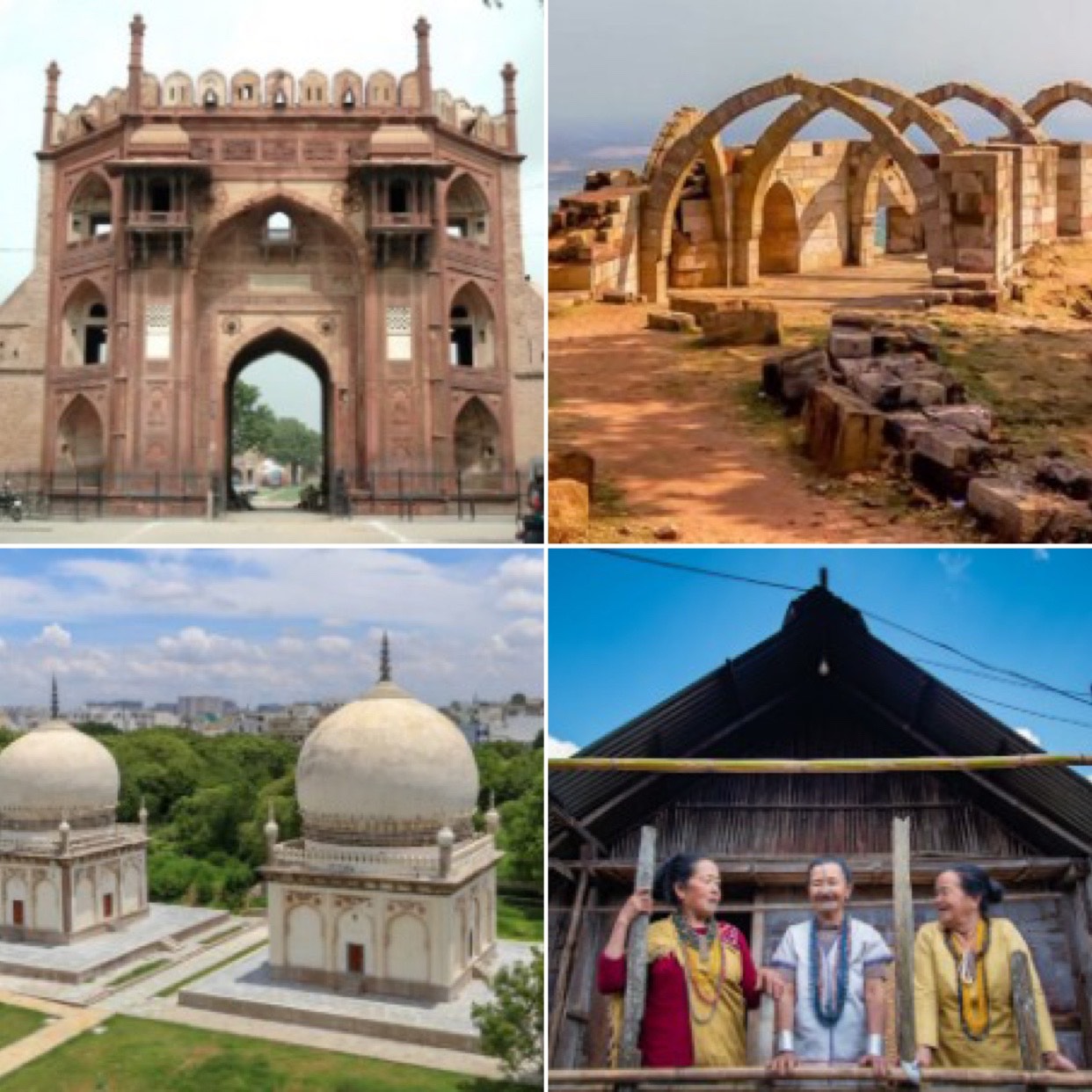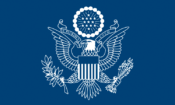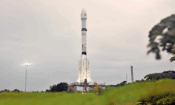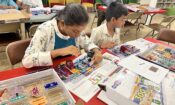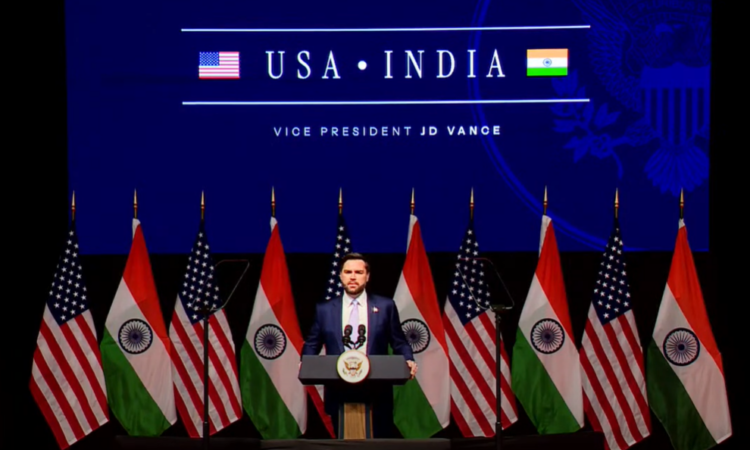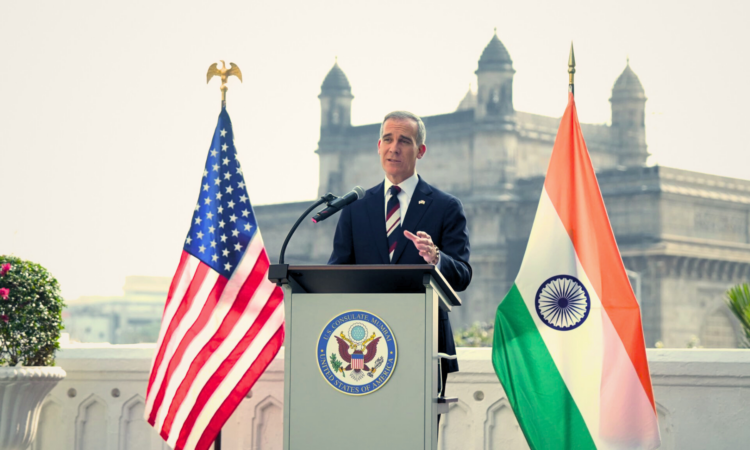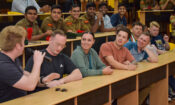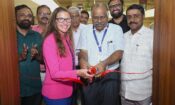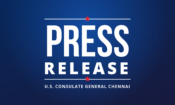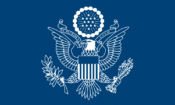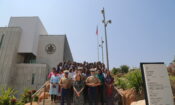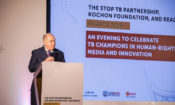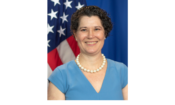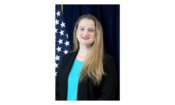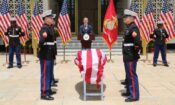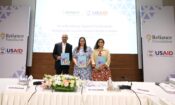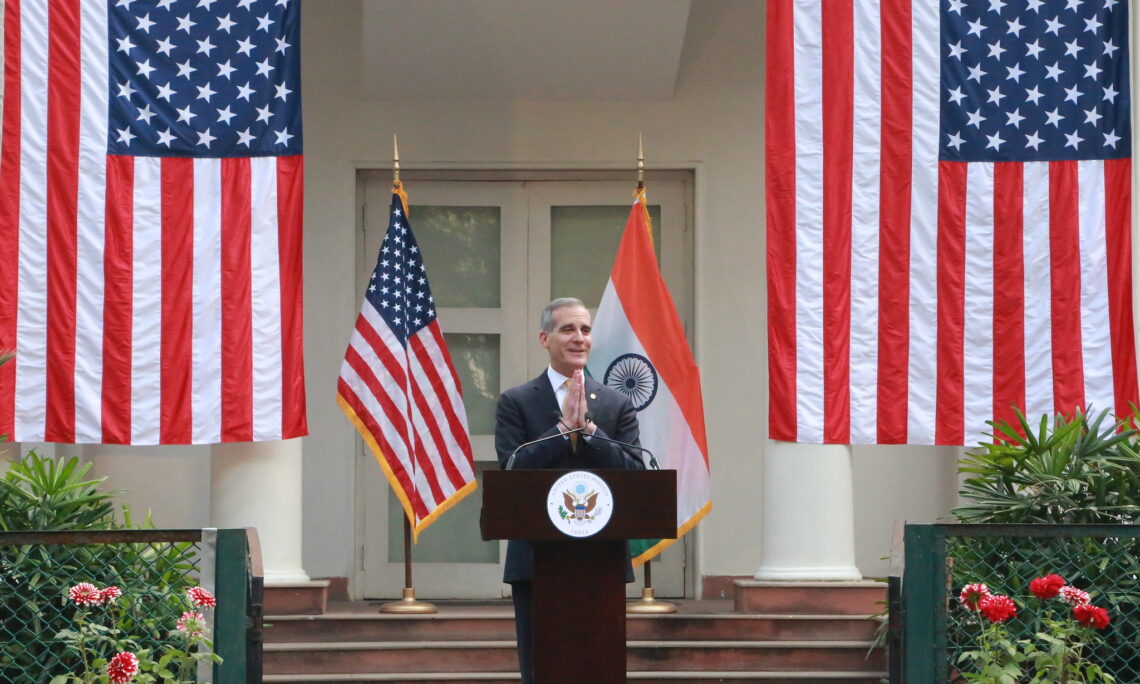Ambassador Eric Garcetti’s remarks as delivered
New Delhi, January 13, 2025
What a great introduction Adam. Thank you for welcoming us to your home, and to this beautiful precipice here on the edge of a great global city. And it’s so wonderful to see all of you here. Good afternoon my friends, नमस्कार दोस्तों (namaskar doston). It’s great to be here with each one of you here today to mark the turning of a page and the completion of a chapter.
I just want to say before I start too that I’m a native of an amazing city called Los Angeles, and I want to thank so many of you that have reached out to me in this past week as my beloved city of angels suffers from the most brutal wildfires we’ve ever seen.
My own parents are displaced from our family home. Our eldest daughter and our grandchildren from a second fire are displaced from just blocks away from that. Thankfully, they are all safe, but so many have lost everything, and some have lost their lives. So, I ask you to continue to keep them in your thoughts, keep them in your prayers, keep them in your good wishes, and thank you for the kindness you have shown me as an Angeleno in the midst of all of this.
Today, as was mentioned, we’re here at Fulbright House, which is this beautiful and historic home that the United States India Educational Foundation established 75 years ago, and our flagship, of course, Fulbright Academic Exchange Program, are both housed. And thank you, Adam, to you and the entire USIEF team for hosting us. Thank you for the work you do every single day to embody what this bridge between America and India is all about.
But you know, standing here today in this beautiful place, footsteps from where I first woke up as a 14-year-old after a long flight and I first took in this great city, the capital of this amazing country, when I was a 14-year-old.
Standing here today is somewhat bittersweet. In the blink of an eye, this humbling opportunity to serve my beloved United States of America as Ambassador to this exceptional country is finally nearing its end.
You know, moments of transition afford moments of reflection, or as you’ve often heard me say, the years tell us things that sometimes the days cannot see. And I’ve also invited my colleagues, since I became Ambassador, to embody, and I’d like to invite you to your future, backwards looking selves – who we might be some 20 years from now, thinking about this very day, looking back on what we did and asking whether or not we did it with the urgency that the moment demanded.
Kabir the Great North Indian mystic poet, revered by Hindus, Muslims, Sikhs and many more alike, perhaps, wrote much more poetically about this, when he wrote: “काल करे सो आज कर, आज करे सो अब, पल में प्रलय होगी, बहुरी करोगे कब।!” “Finish tomorrow’s tasks today, and today’s tasks right now. When would you finish them, if the world were to end in the next moment?”
In other words, we never know, as I’m witnessing in my hometown and in our lives, what the next day brings. But if we look back in our future, backwards looking selves, at this moment, with the urgency of what is possible for today, if we plant those seeds, we will look back, and I am confident, see amazing product of the work, that is the U.S.-India relationship.
My time serving as the United States Ambassador to India has put me at the front line to witness and to help drive how compelling, consequential, and comprehensive this relationship now is. It has been one of the personal honors of my lifetime. But I know for our country too, this is one of the greatest relationships our country has ever known. And the privilege to leave this team, which is now going to be in the hands of our amazing DCM Jorgan Andrews, excuse me. I promise I’m not crying. I just have something in my throat. I’m sure I’ll cry later but, it is showing us how compelling this moment is. But the smart, the smartest, most hard working, most committed public servants that have I ever had the honor of serving with, that has been Mission India. To put it in Hindi, it’s been “शहद जैसा मीठा,” as “sweet as honey.”
For the last three weeks, I’ve given three speeches, and today is the fourth and final speech, summarizing the progress we have made, charting a blueprint for the future, in what I call the four P’s.
You know, a diplomatic mission is like a building, filled with all sorts of structures and rooms, closets, even things that get so big we don’t even know what they are. And now our diplomatic mission is a mansion here, the second largest mission we have in the world.
But it’s become so big, sometimes it’s difficult to describe everything we do. I mean, instead of one summary speech, I’ve had to subject you to four. But I was inspired to describe the four P’s, to describe our work through these four P’s, our efforts to preserve the peace, to pursue a joint prosperity, to protect our mutual planet, and to promote our common people. It’s like an Indian temple’s four cardinal points. Think of them as meeting under a common शिकारा (shikara), the central tower of this, our mission, on a mission.
But this last speech, people, it’s about you. It’s about us. It’s about the people that connect across oceans and cultures, religions, time, and geography for a common purpose – to better the life of our two nations and the world that we inhabit.
And when I look back on my time in India, I know we will record so many accomplishments over the last two years: record trade, record visitors, record defense exercises and military contracts, record students, record investments, record cooperation in space and on the seas. But equal to the accomplishments, the things we have done, maybe even larger, I will take home with me most deeply, the people I have met and how you made me feel.
You know, I’ve traveled to 27 Indian states, eight union territories, in just 21 months. I’ve boarded a plane 173 times, on 73 trips, to see and to meet political leaders and students, entrepreneurs and laborers, farmers, activists, educators, researchers, investors, religious leaders, even a Bollywood star or two.
And from meeting with health activists in the jungle villages of Nagaland, laughing with my daughter with first-in-their-family, female students at a school on the edge of the desert in Rajasthan. Sipping chai with brave soldiers at 17,000 feet in the cold winter of Ladakh, or bathing in the warm waters of Kanyakumari with Indians rising to meet the rising sun against the backdrop of the Indian Ocean – our time together has touched my heart more deeply than I could have imagined.
So let us celebrate, let us strengthen, and let us expand those people-to-people ties in the months and the years and the decades to come. Because through education and through culture, through sports and through travel, we connect not just two countries, but two peoples together, two loving peoples whose hearts have never been more aligned, whose heads have never looked at the world as similarly, and whose feet are ready to move together into uncharted territory faster than ever before.
Education
Let us start with education. We’re here in front of this building that has stood for how we connect – students. The cornerstone of a deep bond between our peoples from the beginning. From early childhood education through university and even beyond, the United States and India continue to nurture the next generation of leaders, equipping them with skills and experiences they need to confront the world’s greatest challenges.
The last two years have seen our U.S. Agency for International Development, USAID, partner with India to strengthen state and national education programs, improving curriculum design, teacher training, digital learning schools and multiple languages across the geography of this country. We’ve made it a priority to expand access to education for girls and for students with disabilities.
Together, we’ve made a difference for more than nine million students. That’s more than the entire population of many countries that we have diplomatic missions in. And a particularly inspiring program has been USAID’s partnership with Sesame Workshop for the Learn, Play, Grow initiative. I never knew Elmo spoke Hindi, but when I finally heard Elmo speak Hindi, it was a very happy moment. It showed how we bring elements of our education system and India’s education system together to make it multiplicative, as I often talk about, not just India plus the U.S., but India times the U.S. And perhaps the most visible sign of our thriving and growing educational partnership is, of course, university students.
And I’m proud that since becoming Ambassador, India has become the number one source of higher education students to the United States of America. Number two is not even close. Now, 23 percent exponential growth and 23 percent growth last year alone and one-in-four foreign students studying at American universities are proudly Indian students, enriching our universities and bringing something marvelous back to India. Thank you for that work together. Hardly a week goes by where we don’t have chancellors and presidents, professors and students coming here, looking at educational opportunities, research partnerships, and even launching new joint degree programs, where you can study in India or the U.S. and get a degree recognized in both countries.
A flagship program of our nation is optional practical training, which nearly 100,000 Indian students are now engaged with in the United States, allowing them to stay in the United States to gain a specific industry and research experience, to build a stronger workforce for both America and for India.
And today, more than 550 Indian nationals are contributing their expertise to groundbreaking research at the U.S. National Institutes of Health, NIH, their intramural laboratories, which is the highest number of foreign biomedical students from any country, currently at NIH.
I kind of get the feeling that Indians love Americans, and Americans love Indians, don’t you think? And we can feel that on campuses and in research facilities, in the places where we speak each other’s language, but we always add something new to the work that we’re doing. Thirteen percent of research publications, eleven percent of NIH grants are now helping save lives with the U.S. and India relationship together.
But as you know, this is hardly a one-way street. I first came here as a high school student, returned as a university student studying Hindi and Urdu and looking at Indian culture. And today, increasingly, American students are coming to India, not just vice versa. In fact, we’ve tripled the number of U.S. university students studying in India. Still not high enough, but it’s a great foundation, and if we keep up that momentum, one day, we may see as many American students learning from Indian universities as we do vice versa.
And we support lifelong learners. I don’t care if you don’t have a student ID card right now. You have something to learn. So, we invest in an array of professional and cultural exchanges for people who are already mid into their careers, enriching understanding, seeding friendships, and sparking innovation.
One of the best parts of traveling India was meeting people in every single state who just, with a smile on their face, wanted to tell me about the time they had been in Colorado or California, or the town they went to in Iowa or Maryland, where they met someone who they still counted as a friend, and how that trip changed their lives. In fact, in these last two weeks alone, 10 Gandhi King scholarly exchange initiative participants from the United States are here traveling in the footsteps of Mahatma Gandhi to learn more about his incredible legacy and the impact that he had on Dr. Martin Luther King, which changed our country. Other exchanges share information on environmental best practices, supporting girls in STEM, coaching budding entrepreneurs, and so much more.
Culture
But you know, education really is a pathway to greater cultural understanding. And students and scholars and scientists aren’t the only things flowing across U.S-India borders. Our cultures are too. We’re filling theaters in America, theaters in America with Indian movies. And India remains one of the most faithful overseas audiences for the product of my town, the Hollywood blockbusters.
We’ve seen breakthroughs, from [Bollywood song] “Natu-Natu” winning the Academy Award for Best Original Song in 2023 to the cinematic artistry of The Elephant Whispers, produced by our own Global Media Makers alumna Guneet Monga, that won an Academy Award for the Best Documentary Short Film. Bhangra is bringing down the house at American music festivals. And American jazz inspires India through legends like Herbie Hancock and Diane Reeves, who recently visited here to honor Dr. Martin Luther King’s legacy and to spread our most beloved musical genre here and in Mumbai.
In addition to film and music, we’ve supported performances that call for the end of violence against women like The Vagina Monologues, produced and performed in Gujarati for the first time. We’ve celebrated writers through the translation of Maya Angelou’s celebrated works, and participating in book festivals across the country, in Jaipur, which is probably the greatest book festival and literary festival in the world. And our commitment to cultural exchange includes cultural preservation as well.
You can’t write the future if you don’t know the past. America believes that too much of Indian culture has been taken away from India. In some cases, stolen from India. So, our Mission got busy, and in July, we signed the landmark U.S.- India Cultural Property Agreement. Thank you to Gloria, the entire team from Public Diplomacy, and [the team] in Washington that made this dream of India and for India, and of America and for America come true. Agreements like this prevent the illegal trade of cultural property and simplify the process by which looted and stolen antiquities can be returned to their country of origin.
We’ve also seen exceptional law enforcement cooperation in this area. Since 2016, the United States has facilitated the return of 578 priceless cultural artifacts here to India, where they deserve to be. The highest of any country, with more than half of these antiquities returned during the Prime Minister’s Official State Visit just last year. I hope that more of these artifacts can be returned to India globally, and in turn, then legally, those artifacts can continue to be loaned out to the world, as we saw when the Metropolitan Museum of Art did not just one, but their two first Indian art exhibitions in the last 18 months, bringing that great culture to the world in New York City and beyond.
This agreement follows on our long history of museum and cultural exchanges between our countries and private sectors. Exchanges like the Getty Foundation’s collaboration with the CSMVS Museum, of course, in Mumbai, to bring antiquities as part of an ancient world’s new exhibit on display there.
You see, Indian history isn’t just for India. We recognize Indian history is world history. It’s world heritage, and it’s been hidden and written out of history for too long. So, we’re proud to turn this page together and write a chapter that will return India’s great civilizational culture to the center, not just of this country’s, but of the world’s focus as well.
Cultural exchanges extend, though, beyond the screen, the stage, the classroom, and museums. As our students, filmmakers, curators, musicians, and artists continue to strengthen the deep bond between our peoples, so too do our sports teams and leagues. In fact, this is probably the culture that people consume the most in the world today.
While cricket may not yet be the national pastime in the United States, and baseball will always give you a run for your money, we’ve seen massive growth of this in the United States. We’re already the second-largest streaming market for cricket in the world. We are proud to host the T20 World Cup. I witnessed the United States almost beat India, but for an ambassador luckily we didn’t, so I could safely return. But we showed that we’re getting more and more competitive.
Some joke that there was the Indian A team and then the Indian H1B team playing for the Americans. But we’ve seen those investments. My friend Shahrukh Khan, who co-owns the Los Angeles team, which is now your T20 champions, the Knight Riders. And many of you know that since I led the bid to successfully bring the Olympics back to America in Los Angeles, I’ve shared a dream with my Indian friends to make cricket an Olympic sport once and for all.
And maybe years from now, when nobody remembers anything else that I did as Ambassador, Indians will remember that I helped put cricket into the Olympics for L.A. in 2028. Something I got to announce last year here, when the International Olympic Committee was meeting in Mumbai during the Cricket World Cup on the day of the India-Pakistan match, a day after we had finished the negotiations. So that we could see finally, this great sport, and maybe the gold medal count for India go up where it’s supposed to be.
And shortly thereafter, I had the honor, in Bengaluru, where this coming week we’ll be opening up the site of our new consulate, I had the honor of meeting the Indian cricket team for the blind – one of the most inspiring meetings I’ve had as Ambassador, maybe in my life. And I’m advocating for its inclusion in the 2028 Paralympic Games, and I’m rooting for India’s bid also as a future host for the Olympic Games. It is time for the most populous country in the world to also be an Olympic country as well.
Now you know that I’ve been here long enough to talk about cricket all day long, but I wouldn’t do our other sports much justice.
So, I wanted to mention that last summer we launched #PlayWithUs- a little pun on us and U.S. – a Mission India-wide digital campaign designed to harness the unifying spirit of sports and cultivate stronger ties among our people through our sports. It is a series of videos featuringd celebrated Indian cricket players like Virat Kohli, girls from the NBA Basketball Academy that I got to play with in Mumbai, and U.S. Women’s Ultimate Frisbee athletes and coaches. These efforts reached over 25 million Indians and show that sport has the power to connect our people. And through this campaign, Mission India leveraged a set of networks and resources to promote sports as a means of advancing the U.S.-India people-to-people relationship – developing girls’ athletic and leadership skills and promoting accessibility for people with disabilities.
Consular Services
So, there you have education, culture, sports. But you know students can’t study, museum directors can’t collaborate, athletes and business leaders and tourists can’t travel without the most direct way our mission brings peoples together: visas. And I know it’s the thing that Indians contact us about the most, certainly talk to me about the most. You guessed it. The issuance of visas. Deeper than the Pacific Ocean, wider than this entire globe, is the demand of Indians to come to America. Some see this as a problem. I see this as an incredible opportunity, an expression of the closeness that we have, and the desire for us to get even closer.
You know, when I was Mayor, I used to say, “we can’t work on the big things until we get back to basics.” For a city, when you run a city, getting back to the basics means taking care of the streets – filling the potholes, ensuring that people could move smoothly through the town. But for a diplomatic mission, I learned very quickly that visas are our potholes. The core work that we do. And so we’ve really focused on trying to make our services better, our numbers expand, and to serve Indians with the opportunity to connect directly and in person with the United States through travel. And I’m so proud of what we’ve accomplished over the last two years. Our team from Kolkata to Mumbai, Hyderabad to Chennai, and of course, here in New Delhi, and in centers around the country where we do some of the preliminary work for visas, we’ve worked to streamline visa processing to keep up with this incredible demand. Since becoming Ambassador, we’ve increased our visas by more than 60 percent, eliminated wait times for all visa types, except for first- time visitor visas, which where the wait time is down 75 percent from our peak, still much further to go, I know. But a great accomplishment. And we added a record number of new hires as Consular Officers to this mission. We’ve implemented new technologies. We’ve even used AI to analyze some of the ways we can get better. And the result? For a second year in a row, we issued more than one million nonimmigrant visas, including a record number of visitor visas. In fact, more than five million Indians currently hold a United States visa.
In 2024, the U.S. Mission to India met visa interview demand for all first-time student visa applicants, ensuring that every student could arrive on time and their parents could feel calm about their child going to the United States. And the U.S. Citizenship and Immigration Services completed more that 1,600 relative petitions. Our visa team issued tens of thousands of immigrant visas. And India is now the number one source of overseas adoptions for Americans as well. We’ve reunited more family members. We’re literally building families across the Indo-Pacific together. All of this incredible exchange and accomplishment is reflected in what is perhaps our greatest secret weapon in the United States, of this relationship: the four-million-strong Indian diaspora that calls America home. Every single day, because I know there’s been a lot in the news recently about them, they enrich the tapestry of America. They fuel the vibrant connections between our two countries. Indian students, Indian American immigrants are there helping run our world’s most important universities, our companies, our research entities. They’re providing innovation and a record strong tax base. They fill needs from rural medicine that can’t be met to small business operations that we have trouble finding employees for. This makes America, in my opinion, a better and a stronger country.
We never know what the future holds, but I’ll say this to my fellow Americans: the more ties that we have to more Indians, and the more ways we can find to grow our economic and educational exchanges, the stronger America and India will both be. In a world that too often cedes space to forces that seek to divide us, both internally and internationally, let us be a voice, as we have been, to care for each other across the things that too often separate us. To care across geography and religion, language and income, identity and so much more. Let’s prove any haters wrong the way we always have: by meeting instead of tweeting, by investing instead of protesting, by connecting instead of objecting, and by bringing people together acknowledging in this day and age, there will always be some divisive voices, but let’s never mistake the loudest or most clickable comments for being the most representative. We know that there are Americans and Indians who are invested in this relationship, and overwhelmingly, our populations want this relationship to deepen. The truth is, as I said, Americans love Indians and Indians love Americans.
So, as we look to the future, my friends, on this day, just a week before our country’s democracy will move forward with a new administration -as we saw democracy turn the page here in this country with an election last year – think about how lucky we are as people to live in two large, diverse democracies. As I’ve often said, democracy is tougher to manage the non-democracy, but it is the best system out there. And diverse populations don’t mean that everybody gets along but think of how boring life would be if we all looked the same, all spoke the same, and all acted the same.
You know, 230 years of formal cooperation between the United States of America and India, since we established our first diplomatic mission in Kolkata, we can honestly say that this relationship has never been stronger. That we are always better when we are together. America sees its future with India, and India sees its future with America. A future defined by friendship, defined by trust and together, an unstoppable force for good in the world today.
And so, we have to ask ourselves at these moments, when the years change, did we do what was important and lasting? Did we do it with a sense of urgency, purpose, and determination? To my colleagues who will continue the work – wake up every day and imagine yourself looking back on this day with urgency, purpose, and determination, and yes, of course, patience. Working on the U.S.-India relationship requires patience, as does work to grow supply chains, keep our world safe, and heal our planet. But may we each be a gardener in this work. In Kabir’s work. Sorry, in Kabir’s words, ““ धीरे–धीरे रे मना, धीरे सब कुछ होय। माली सींचे सौ घड़ा, ऋतु आये फल होय। “Slowly, slowly, O mind. Everything unfolds at its own pace.” The gardener may water with a hundred pots of water, but the fruit only arrives in its season.
So, as I prepare to leave this job as your Ambassador, I see a garden full of Indians and Americans who are watering our work. I’ve seen the seeds planted. I’ve seen the sunshine come upon us here on this earth, and I can see the fruit begin to arrive with the spring that is ahead. Count on me to be there with you India as we taste the sweetness in the years to come. धन्यवाद and thank you.





